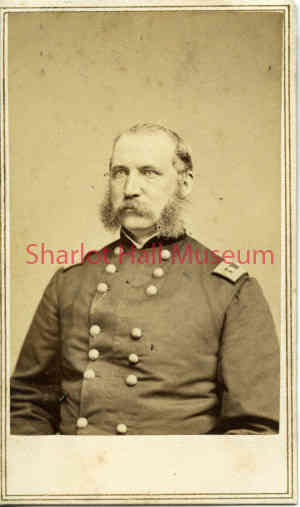John Foster
details
Matthew Brady E & H. T. Anthony / New York po0677p.jpg PO-0677 B&W 1700-0677-0000 po0677p Print 2.5x4.5 Historic Photographs 1860-1864 Reproduction requires permission. Digital images property of SHM Library & ArchivesDescription
Formal military portrait of Major General John Gray Foster. NOTE: This photo was previously misidentified as Lieutenant Edward Lewis Stevens.
John Gray Foster (b. 1823 - d. 1874) was born on May 27, 1823 in Whitefield, New Hampshire. A graduate in 1846 from the Military Academy (unknown), he was assigned to the Engineer Corps. He served in the Mexican War (1846-1848) under General Winfield Scott, then Assistant Engineer on coastal survey work. He was a defender of Fort Sumter (South Carolina) on the night of December 26-27, 1860. He was commissioned Brigadier General of Volunteers in 1861 for services at Roanoke Island in General Ambrose Burnside's expeditions. Other assignments included Command of the Department of North Carolina and Virginia and the Army and Department of the Ohio. After a bad fall from his horse he was given command of the Department of the South.
After the war, Foster commanded the Department of Florida and was superintendant of river and harbor construction in Boston and Portmouth. John had one daughter, Annie M. Foster who married Major Henry Seton who was stationed in Arizona Territory. John died on September 3, 1874 in Nashua, New Hampshire.
Purchase
To purchase this image please click on the NOTIFY US button and we will contact you with details
The process for online purchase of usage rights to this digital image is under development. To order this image, CLICK HERE to send an email request for details. Refer to the ‘Usage Terms & Conditions’ page for specific information. A signed “Permission for Use” contract must be completed and returned. Written permission from Sharlot Hall Museum is required to publish, display, or reproduce in any form whatsoever, including all types of electronic media including, but not limited to online sources, websites, Facebook Twitter, or eBooks. Digital files of images, text, sound or audio/visual recordings, or moving images remain the property of Sharlot Hall Museum, and may not be copied, modified, redistributed, resold nor deposited with another institution. Sharlot Hall Museum reserves the right to refuse reproduction of any of its materials, and to impose such conditions as it may deem appropriate. For certain scenarios, the price for personal usage of the digital content is minimal; CLICK HERE to download the specific form for personal usage. For additional information, contact the Museum Library & Archives at 928-445-3122 ext. 14 or email: orderdesk@sharlot.org.




